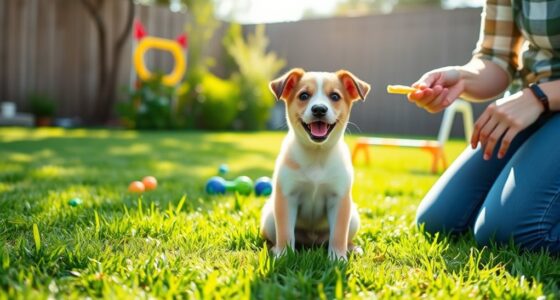To keep your puppy safe during at-home grooming, use gentle brushes suited to their coat, and always handle them calmly to build trust. Bathe with lukewarm water and puppy-specific shampoo, avoiding contact with eyes and ears, then dry thoroughly. Trim nails carefully, only clipping the tip without the quick, and ensure grooming tools are within reach to prevent accidents. If you follow these tips closely, you’ll create a comfortable routine that benefits your puppy’s health and happiness.
Key Takeaways
- Use gentle, breed-appropriate grooming tools and mild shampoos designed for puppies to ensure comfort and safety.
- Bathe puppies with lukewarm water, avoiding eyes, ears, and nose, then rinse thoroughly and dry with a soft towel or cool blow dryer.
- Brush regularly with suitable brushes, working gently around sensitive areas and detangling mats carefully to prevent discomfort.
- Trim nails carefully with small, puppy-specific clippers, avoiding the quick, and seek professional help if unsure.
- Secure your puppy during grooming, handle it gently, and practice routines patiently to create a safe, positive grooming experience.

Grooming your puppy at home is a rewarding way to keep your furry friend clean, healthy, and comfortable. When you’re ready to start, having the right puppy grooming tools is essential. These tools include gentle brushes suited for your puppy’s coat type, nail clippers designed for small paws, and mild shampoos formulated for puppies’ sensitive skin. Using the appropriate grooming tools makes the process smoother and prevents discomfort or injury. Before you begin, it’s critical to review grooming safety tips to guarantee a positive experience. Always handle your puppy gently, and never force grooming if your puppy becomes anxious. Creating a calm environment and offering treats can help your puppy associate grooming with positive experiences.
Groom your puppy at home with gentle tools and safety tips for a happy, healthy grooming experience
When bathing your puppy, use lukewarm water and a specially formulated puppy shampoo. Wet your puppy thoroughly, avoiding the eyes, ears, and nose. Use your hand or a gentle cup to pour water, and lather carefully, massaging the shampoo into the coat. Rinse thoroughly, making sure no soap residue remains, as leftover shampoo can cause skin irritation. Dry your puppy with a soft towel or a low-heat blow dryer set on cool, keeping the noise minimal to prevent fright. Remember, never leave your puppy unattended in the bath to avoid accidents or slipping. Proper bathing techniques help maintain your puppy’s skin health and coat condition, especially since delicate skin requires gentle care.
Brushing your puppy’s coat is another key grooming task. Depending on the breed, you might need a slicker brush, a comb, or a pin brush. Regular brushing removes loose hair, prevents mats, and stimulates blood circulation. Be gentle around sensitive areas like the belly and behind the ears. If you notice mats or tangles, work through them carefully with a detangling spray and your tools, avoiding pulling or tugging. Consistent brushing helps your puppy become accustomed to grooming, making future sessions easier and less stressful.
Nail care is often overlooked but is essential for your puppy’s comfort and health. Use nail clippers specifically designed for puppies, and trim only the tip of each nail, avoiding the quick— the sensitive area that contains nerve endings and blood vessels. If you’re unsure, consult your vet or a professional groomer for guidance. During trimming, keep a steady hand and watch for signs of discomfort. If your puppy shows resistance, take a break and try again later. Proper nail care prevents painful splits and ensures your puppy can walk comfortably.
Throughout the grooming process, prioritize safety at every step. Use grooming safety tips such as securing your puppy to prevent sudden movements, keeping grooming tools within reach, and never rushing the process. With patience and practice, your at-home grooming sessions will become a bonding experience that keeps your puppy happy, healthy, and well cared for.
Frequently Asked Questions
How Often Should I Groom My Puppy?
You should groom your puppy every 4 to 6 weeks, depending on their breed and coat type. Regular grooming helps with puppy dental care and keeps their coat healthy. Incorporate crate training tips by making grooming a positive, calm experience. Regular brushing and nail trims prevent discomfort, while consistent grooming builds trust and eases future grooming sessions. Keep an eye on their needs and adjust frequency as they grow.
What Grooming Tools Are Safest for Puppies?
You should use gentle grooming tools like soft-bristled brushes, puppy-specific shampoos, and rounded-tip nail clippers to guarantee safety. Avoid common puppy grooming myths that suggest harsh tools are okay; instead, follow grooming safety tips to prevent injury. Always supervise your puppy during grooming, use calm techniques, and choose tools designed for their size and coat type, making the process safe and stress-free for your furry friend.
How Can I Prevent My Puppy From Biting During Grooming?
Imagine your puppy’s tiny paws as delicate flowers needing gentle care. To prevent biting during grooming, use puppy biting prevention strategies like redirecting their attention with a toy or treat. Employ gentle handling techniques, speaking softly and staying calm, to create a soothing environment. Consistency is key—praise calm behavior and stay patient, helping your pup associate grooming with positive experiences and reducing their urge to nip or bite.
When Should I Start Grooming My Puppy Regularly?
You should start grooming your puppy as early as 8 weeks old to establish a positive grooming schedule. During this time, focus on gentle puppy socialization to help them become comfortable with handling. Regular grooming sessions help prevent future issues and build trust. Keep sessions short and positive, gradually increasing duration as your puppy adapts. Consistency and patience are key to making grooming a stress-free routine for both of you.
Are There Grooming Products Specifically for Puppies?
Are there grooming products specifically for puppies? Absolutely! You should look for puppy grooming products, like shampoos, conditioners, and brushes, designed especially for their delicate skin and coat. Specialized puppy shampoos are gentle and free from harsh chemicals, making bath time safe and comfortable. Using the right products helps prevent irritation and guarantees your puppy’s grooming experience is positive, setting a foundation for healthy habits as they grow.
Conclusion
Grooming your puppy at home is like nurturing a delicate garden—you care for each part to help it flourish. With gentle bathing, regular brushing, and careful nail care, you’re tending to their happiness and health. Keep it consistent, stay patient, and enjoy each moment as your puppy blossoms into a happy, confident companion. Remember, your love and care are the sunshine that helps your furry friend grow strong and beautiful every day.










